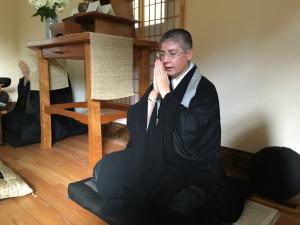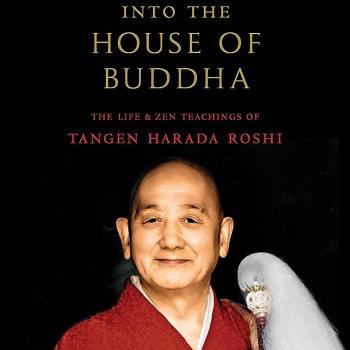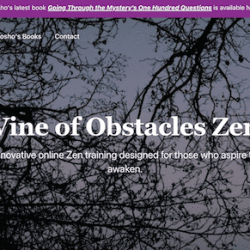I was talking with an Zen teacher friend this past week and he mentioned that his next meeting was with a practitioner who wanted to become a Zen priest. “Any thoughts about what I might say to him?” he asked.
“Just discourage him,” I said.
We went on to talk about why someone might want to become a Zen priest these days. Lay teachers can do pretty much everything that priests can do to share the dharma, if that’s a person’s intention. So what’s the difference? What’s the point?
For about the last 150 years in our Japanese derived lineages, Zen priests have been able to have sex, drink alcohol, and eat meat, distinguishing themselves from most of the rest of the vinaya-following Buddhist world. I’ve written a bunch about this issue on this blog, including this post from 2009 that summarizes our tradition in transition.
The move during the Japanese Meiji period was influenced by the appearance in Japan of Western Protestant ministers who could do all of the above. “Modernizing” meant moving in the Protestant direction. That direction seems to have continued here in the West where the lifestyles of most Zen priests is hardly distinguishable from householders. Aitken Roshi, for instance, was a lay teacher who lived a life much more like a temple priest than most Zen priests these days.
The body practice of wearing robes has become much like the vestments worn by our Protestant friends rather than a practice of following the body of the teacher.
So what’s the point of being a Zen priest?
Simply put, to develop competency in the body practice/art form of Sōtō Zen. This follows Dōgen’s emphasis on body-in-the-body practice throughout the day-and-night with specific attention to the “how to manifest the dharma in this situation?” How to sit, walk, stand, bow, drink, eat, sleep, toilet, etc., in accord with the buddhadharma?
The idea that you might become a priest to have a credential to use for your benefit, dharmically or financially, or for the benefit of others, is whacked. It isn’t about you. It isn’t about them. It is about learning this important body art so that it be might passed on to the next generation.
It is hard to develop competency with this, to become an adept, without having some monastic experience, a couple 90-day angos, for example, is a nice start. That takes a deep dedication to the “how-to-do-it?” koan, foregoing professional advancement in other areas. Some people protest this and insist that although they choose not to do the training, they still have the right to be Sōtō Zen priests without such training, and it certainly appears that there are Sōtō Zen teachers that agree.
It is sad to see Sōtō Zen priest training reduced to an entitlement.
Kōun Franz writes (click here for more), “If you enter into a relationship with a teacher defining success as being understood (or seen), then you’re aiming in the wrong direction from the start. If I approach someone as a student, it is to get over myself and to see what the teacher sees—not in me (because that’s not where the teacher is looking) but in the Dharma. In this moment. In this action. I will study how my teacher sits, how she eats breakfast, how she greets people she doesn’t know, and I will imitate it all, not so that I can be her—I can’t—but so that I can step beyond my own story of who I am.”
In the same vein, to become a Sōtō Zen priest makes sense if you are studying with a Sōtō Zen priest and you want to see with the same eyes, hear with the same ears. Then you might enter into that practice fully, wearing the same clothes, walking the same walk, bowing the same bow.
This is the great strength of the Japanese Sōtō Zen training system. When I did some training in Japan, even though at that time I’d trained closely with a Japanese teacher, I found it to be so different from practice in the US, so much more of a body practice (also in a koan introspection place like Bukkokuji), for that and other reasons it was a really important for me and a great experience too – especially in retrospect. When I returned to the US it blew my mind how much talking happened in Zen here and how little “what we do with the body” was/is emphasized.
That occurred to me this week too as I watched someone who has been a Zen student for some years saunter into the zendo with his hands deep in his pockets. Uffta.
The importance of fuhgeddaboudit for a Zen priest
When Dòngshān was asked about why he only half agreed with his late teacher, he said, “To agree completely would be unfilial.”
And “Wúmén’s Cautions” begins with this: “Following rules, observing regulations – binds self without rope. Moving unhindered without fetter – a devil army outside the way.”
So what to do?
Just like zazen is a creative endeavor – how to play the instrument of this bodymind so that we are in tune with the buddhadharma – the body art of priest practice in Sōtō Zen is a creative endeavor. This point is made again and again in the classic literature. In the first case of the No Gate Barrier, “Zhàozhōu‘s Little Dog,” a monk asks a question and Zhàozhōu gives an answer that defies the orthodox teaching. His answer, “mu,” has so much juice that we’re drinking from it still.
In the second case, “Bǎizhàng’s Wild Fox,” a monk asks a question and the old Bǎizhàng answered with something close to the orthodox position. This teacher is reborn as wild fox for a long time. The message is clear – if we stick to the orthodox teaching, we spin around and around.
In this old koan literature, an accomplished Zen practitioner is referred to as an “adept,” sometimes with these characters: 作家, “author” in contemporary Chinese. So “adept” could also be translated (creatively) as “creative.”
I think this is a side of our practice not emphasized enough. We are born into a tradition, we master the tradition, and then we have to go beyond it in the particular circumstances of this life.
For a Sōtō Zen priest, in my view, it is important to become adept in the body practice of Sōtō Zen. But if you are thinking that if you just get your orthodox ceremonies down and undertaken, or stick to the formula for your school (Sōtō or Rinzai or what not), then you’ll be an adept, well, maybe – but are you truly filial?
_________













